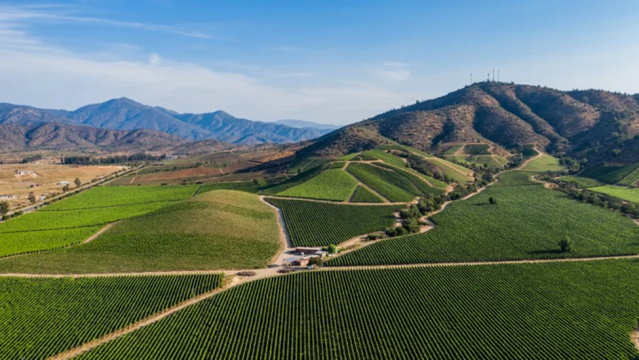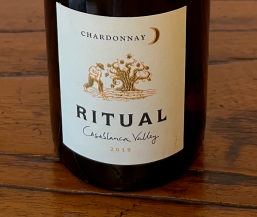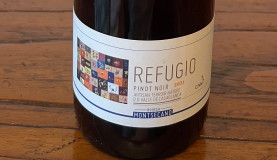 Tasting No 257– September 26, 2023 – Wines of Casablanca Valley, Chile
Tasting No 257– September 26, 2023 – Wines of Casablanca Valley, Chile
1.Tasting Overview
Casablanca Valley is a small wine-growing region located 75 kilometers northwest of Santiago, only a few miles off the coast in central Chile, and the area falls within the Aconcagua Region. The main objective of the tasting is to explore the main types of wine produced in this area.

Type of tasting: Open
Presenters: Marcello Averbug
Participants: R. Arroio; M. Averbug; L. Boccalandro; R. Connolly; C. Estrada; M. Fryer; J. Garcia; C. & A. Perazza; L. & J. Redwood; J. Sanchez; R. Santiago; E. Silva; M. Simões; P. Turina; and G. Zincke.
These are the wines:
- Veramont ‘Ritual’ Chardonnay, 2019.
- Montsecano ‘Refugio’ Pinot Noir, 2021.
- Montsecano, Pinot Noir, 2018.
- Cono Sur, ‘Ocio’ Pinot Noir, 2019.
Menu
- Grilled calamari
- Eggplant parmegiana
- Dark cheken with mashed potato
- Dessert, coffee, tea
-
The Casablanca Valley

View of the Casablanca Valley (@ wine-searcher.com)
Casablanca Valley’s first vineyards were planted in the 1980’s during the revitalization of the Chilean wine industry. The vineyards, then, expanded around the industrial town of Casablanca and vineyards now dominate the valley’s landscape, despite a lack of water for irrigation that has delayed vineyard planting.
The Valley runs for 19 miles east to west from a coastal region 30 km from the Pacific Ocean, to the neighboring region of Valparaiso. This unique geography is what makes the valley’s wines so distinctive. Until the 1980’s most vineyards were planted in warm areas, but the Casablanca Valley have an extremely cool climate.
In recent years, the Casablanca Valley has emerged as a major wine tour destination, given its proximity to the Chilean capital, the Andes Mountains and the Pacific Ocean.
As the region is strongly influenced by the cooling effects of the Humboldt Current, which flows up the west coast of Chile from the Antarctic. Cooling afternoon breezes blow from the ocean towards the mountains in the east, filling the vacuum created by warm air rising in the east. There is plenty of cloud cover, mitigating some of the harsh summer temperatures. Grapes are able to ripen longer, resulting in much more intense and complex wines.
For the last decade Casablanca has became increasingly affected by drought, meaning it’s now more difficult to access water for irrigation. This poses a real threat to producers who are focused on high yield grape growing. The head of Matetic Vineyards says: “massive wine production will be unfeasible in Casablanca; the future lies in small wine production with focus on high quality wines”.
Given that the first vineyards were planted in the Casablanca Valley in the 1980s, the growth of this wine region has been truly spectacular. It is now known as Chile’s top white wine region, producing some of the finest Chardonnay and Sauvignon Blanc in the entire country. In addition, Pinot Noir is popular and very good. The high quality in wine production also results from the ability of growers to adhere to sustainable viticultural practices.
This duo of white varieties have given the region recognition as one of Chile’s top quality wine regions. It has attracted considerable investment from wine companies based in other Chilean regions, who were looking to boost their white wine portfolio, as well as from abroad.
It is the cooler climate that makes Casablanca’s white wines stand out from their local rivals. With a longer ripening period, the white grapes have more time to develop greater flavor complexity, while maintaining sugars and acids in balance, resulting in much more intense and complex wines.. This cool climate, while undoubtedly beneficial, is not without its dangers – crops have been seriously damaged in the past by severe frosts in spring.
Chardonnay, Sauvignon Blanc and Pinot Noir account for 90% of grape availability in this region, while several others are produced in very small quantities.
The main vineyards of Casablanca Valley are: Mar Vineyard; Viña House Casa del Vino; Catrala Vineyard; Veramonte Vineyard; Bodega Montsecano; Viña Cono Sur; Indomita Vineyard; Casas del Bosque Vineyard; Emiliana Vineyard; William Cole Vineyard; Matetic Vineyard; Loma Larga Vineyard; Quintay Vineyard; Kingstone Vineyard; El Cuadro Vineyard; and Casa Valle Viñamar.
-
Information About the Wines
Wine #1. Ritual Chardonnay, 2019
 The producer: Viñedos Veramonte was founded in 1992 and dedicated to farming organically. It is one of the pioneers of the Casablanca Valley and has been recognized for over 25 years for its distinctive wines.
The producer: Viñedos Veramonte was founded in 1992 and dedicated to farming organically. It is one of the pioneers of the Casablanca Valley and has been recognized for over 25 years for its distinctive wines.
In partnership with the Municipality of Casablanca, they carry out a program to benefit small rural farmers in the community, to improve the soils of their vineyards through regeneration, which included selection of beneficiaries, teamwork workshops, plot allotment, constant training in organic agriculture, and assistance with application for public funds and product sales support, among others. From the proceeds of wine sales a percentage is donated to non-profit-organization to promote regenerative agriculture aimed at increasing biodiversity, enrich soils, improve watersheds and enhance ecosystem services.
Veramonte vineyards has four brands: Veramonte and Ritual, from Casablanca, and Primus and Neyen, in Apalta, Colchagua Valley: all examples of quality Chilean wine made from organic grapes grown in their own vineyards.
The wine:
- Vintage: 2019
- Varietal composition: 100% Chardonnay
- Viticulture: Grapes are hand-picked at night, maximizing freshness and vibrancy with whole cluster pressing.
- Vinification: 20% concrete eggs, 20% new 400lts barrels, 60% neutral oak. A portion of the fruit is whole cluster fermented in concrete eggs, increasing texture and fruit flavors. The rest ferments in oak barrels, delivering structure, complexity and silkiness. After fermentation, we stir the lees regularly, in order to achieve maximum expression.
- Alcohol: 14%
Winemaker Notes: An elegant wine of yellow-green color, with expressive aromas of grapefruit, tangerine, pear and quince, and soft hazelnut notes intertwined with subtle hints of oak and vanilla. Soft, elegant and creamy texture with remarkable roundness and a long finish. Its aging in barrels provides body and complexity, which combine perfectly with its fresh, crisp and vibrant acidity. The careful work with lees gives it a soft and silky texture.
Critics scores: 91 pts. (Robert Parker The Wine Advocate); 87 pts. (Wine Enthusiasts); 93 pts. Patricio Tapia – Descorchados).
Wine #2. Montesecano, ‘Refugio’ Pinot Noir, 2021
 The producer: Bodega Montsecano is a collaboration between Ostertag of the legendary Domaine Ostertag, in Alsace, and Julio Donoso of Chile, which started in 2005. They planted 4 hectares of Pinot Noir in Las Dichas, Casablanca, and built a small winery and cellar on the property. The vineyard is biodynamically farmed and is plowed by horse. The undergound geothermal winery is shaped like an egg, and the wine are vinified exclusively in concrete egg and stainless steel.
The producer: Bodega Montsecano is a collaboration between Ostertag of the legendary Domaine Ostertag, in Alsace, and Julio Donoso of Chile, which started in 2005. They planted 4 hectares of Pinot Noir in Las Dichas, Casablanca, and built a small winery and cellar on the property. The vineyard is biodynamically farmed and is plowed by horse. The undergound geothermal winery is shaped like an egg, and the wine are vinified exclusively in concrete egg and stainless steel.
Montsecano participate in the community called Raw Wine or ‘natural wine’, who grow/make/sell/drink clean wine cultivated in a clean environment – pure, fermented grape juice with few, if any, additives, grown without synthetic fertilizers, pesticides, herbicides or fungicides. Many believe that they produce two of the most highly regarded expressions of Pinot Noir in all of Chile.
The wine:
- Vintage: 2021
- Varietal composition: 100% Pinot Noir
- Viticulture: single Vineyard Refugio; biodynamic farming practices
- Vinification: 100% destemmed; native yeast; organic, élevage in concrete egg then in 5000L concrete tanks; unfiltered/unfined. Aged three months in bottle prior to release.
- Alcohol: 12.8%
Winemaker Notes: The wine shows bright raspberry, strawberry jam, with rose petals, violets, and a light component of baking bread. Extremely vibrant with a some green notes and a light, glassy, soft and smooth mid-palate. The light tannin cradles the wine and lends itself to the refreshing acidity with a long, jam influenced finish. Dark ripe cherry and black fruits jump out of the glass with underlying raspberry fruit notes. Rich full fruit, mineral driven, with a long, generous, smooth finish.
Tasting notes: “The 2021 Refugio Pinot Noir has a bright ruby color and an expressive nose, mixing notes of flowers and a meaty touch. It has contained ripeness, good balance and a medium-bodied palate with clean and supple flavors and the granite texture in the mouthfeel. Wild Pinot Noir.” (Robert Parker The Wine Advocate)
A pretty nose of cherries, strawberries, plums, smoke, cedar and violets. Medium-to full-bodied with fine, silky tannins and vibrant acidity. Focused and textured with chiseled character and a flavorful, spicy finish.
Critics scores: 94 pts. (Robert Parker The Wine Advocate); 94 pts. (Patricio Tapia – Descorchados)
Wine #3. Montsecano Pinot Noir, 2018
The producer: Bodega Montsecano
The wine:
- Vintage: 2018
- Varietal composition:100% Pinot Noir
- Viticulture: vineyard Montsecano; biodynamic farming practices;
- Vinification: native yeast; organic, élevage in concrete egg then in 5000L concrete tanks; unfiltered/unfined
- Alcohol: 12%
 Winemaker Notes: From the same producer Bodega Montsecano, this 100% biodynamic hand harvested, single vineyard Pinot Noir is fermented and aged entirely in stainless steel and concrete eggs. Dark ripe cherry and black fruits jump out of the glass with underlying raspberry fruit notes. A condensed and dark spiraling mid-palate shows layers of minerality and complexity, with hints of wet crushed rock (granite), sage, clove and blueberry . Rich full fruit, mineral driven, with a long, generous, smooth finish.
Winemaker Notes: From the same producer Bodega Montsecano, this 100% biodynamic hand harvested, single vineyard Pinot Noir is fermented and aged entirely in stainless steel and concrete eggs. Dark ripe cherry and black fruits jump out of the glass with underlying raspberry fruit notes. A condensed and dark spiraling mid-palate shows layers of minerality and complexity, with hints of wet crushed rock (granite), sage, clove and blueberry . Rich full fruit, mineral driven, with a long, generous, smooth finish.
Tasting notes: ”the wine has a moderate 12% alcohol, reflecting the character of the year and the earlier picking, with red acid berry aromas, a floral touch and depth and complexity. It’s subtle, has detail and elegance and is clean and focused, with very fine tannins and a very balanced palate with integrated acidity. It’s harmonious and elegant.” (Robert Parker’s The Wine Advocate).
The nose is spectacular, a mix of wild herbs, flowers and berries, some rose petals and even a touch of citrus peel, coming through as aromatic and fresh. The palate is perhaps a tad lighter than previous vintages and perhaps a little more “natural.” But it has very good complexity, developing aromas of violets with time in the glass, and it has lots of freshness and balance.
Critics scores: 95 pts. (Robert Parker, The Wine Advocate); 95 Pts. (Patricio Tapia – Descorchados); 92 pts. (Tim Atkin)
Wine #4. Cono Sur ‘Ocio’ Pinot Noir, 2019
 The producer: Viña Cono Sur was founded in 1993 by Viña Concha y Toro in 1993 and is based in Cochagua Valley with the vision of an independent winery with a focus on premium, sustainable wines. Cono Sur prides itself on its pioneering and innovative spirit. It is particularly notable for its wines made from Pinot Noir, and in particular the flagship Ocio, but makes a range of wines from many of Chile’s key grape varieties. The estate has grown considerably since, and now Cono Sur makes wines in most of Chile’s key winegrowing regions. However, Cono Sur’s most important region is arguably the Casablanca Valley, where the Pinot Noir grapes for the Ocio wine are sourced. They were the first in Chile to produce and export Premium Pinot Noir.
The producer: Viña Cono Sur was founded in 1993 by Viña Concha y Toro in 1993 and is based in Cochagua Valley with the vision of an independent winery with a focus on premium, sustainable wines. Cono Sur prides itself on its pioneering and innovative spirit. It is particularly notable for its wines made from Pinot Noir, and in particular the flagship Ocio, but makes a range of wines from many of Chile’s key grape varieties. The estate has grown considerably since, and now Cono Sur makes wines in most of Chile’s key winegrowing regions. However, Cono Sur’s most important region is arguably the Casablanca Valley, where the Pinot Noir grapes for the Ocio wine are sourced. They were the first in Chile to produce and export Premium Pinot Noir.
The wine:
- Vintage: 2019
- Varietal composition: 100% Pinot Noir
- Viticulture: Vineyards Triángulo (85%) and San Antonio (15%); sandy clay soils, benefit from the cool maritime climate, retaining acidity while developing rich varietal character. Grapes are hand-harvested, hand-selected and crushed.
- Vinification: uncrushed grapes underwent a one-week cold soak and then were foot trodden and inoculated with selected yeasts. Grapes are fermented and then put in new French oak barrels for malolactic for 8 months and then spent another 6-8 months- 70% in same barrels and 30% in 2000L foudre. Then wine is rested in stainless steel tanks for 4-8 weeks before being bottled and released.
- Alcohol: 14 %
Winemaker Notes: A deep ruby red, this iconic Pinot Noir has great aromatic intensity expressing notes of red fruits and berries, with a touch of spices and tobacco. In mouth it is smooth and elegant, with a refined concentration and acidity. This wine pairs beautifully with red meats, duck, tuna and aged cheeses.
In “Robert Parker’s” opinion it has good freshness and balance. This wine is produced with the advice of French winemaker Martin Prieur from Burgundy. It’s akin to a modern Burgundy, with generous oak, some toasty notes and notes of orange peel and ripe cherries. It has kept vibrant acidity and comes through as medium to full-bodied with fine-grained tannins. It was bottled in June 2020. It has concentration, acidity and freshness to develop nicely in bottle. Best After 2022.
Critics scores: 94 pts. (Robert Parker The Wine Advocate); 94 pts. (Tim Atkin); 94 pts. (Patricio Tapia – Descorchados).
CV Members Rating (after the tasting)
The tasting took place before revealing the wines’ prices. 16 participants rated them from Acceptable to Excellent. The combined results established the preference order during the tasting.
Cono Sur ‘Ocio’ Pinot Noir 2019 was rated as Best Wine and Veramonte ‘Ritual Chardonnay 2019 the Best Buy. The following Table presents the details of individual ratings and combined results.

REFERENCES:
https://www.wine-searcher.com/
https://www.bowlerwine.com/producer/montsecano
Collection of pictures of Vineyards of Casablanca as presented by Marcelo Averbug
Main Vineyards of Casablanca Valley, Chile
Estimados amigos,
Al investigar los vinos de Casablanca descubrí que la mayoría de los viñedos de esta región son bastante lujosos y modernos. Por eso, además del blog del Club, pensé que sería importante destacar fotos de algunos de estos viñedos.
Ver la página adjunta en .pdf.
Vineyards of Casablanca
Marcelo Averbug
.o0o.
